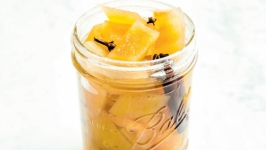Watermelons
THEY MEAN SUMMER’S HERE
I don’t think anything says “summer” as much as watermelons do. My childhood memories of watermelons feature huge, heavy ovals, with dark green skin, a thick white rind and bright red flesh with lots of black seeds.
My father would often bring watermelons home with him because near his work there was a small truck farm. He’d take the biggest knife in the kitchen and cut the watermelon in half, then into half-moon slices, and pass them around to us and the other neighborhood kids. We’d sit on the back porch, juice dripping down our chins and hands, and see how far we could spit the seeds—a practice not approved of by my mother. She would chide us as she washed us up with the garden hose.
At least once every summer, my mother would use the rind of one of the watermelons to make preserves, which were always on the table at Thanksgiving and Christmas. My grandmother, who came from Tennessee, gave my mother the recipe.
As a child, I didn’t like these watermelon preserves, but then I wasn’t really fond of any kind of preserves. As a young adult, I discovered the sweet and sour condiments that accompany Indian curries and Indonesian rijsttafel, and I found that watermelon preserves were a perfect pairing with the spicy foods, along with cooling yogurt-based raitas.
Also as a young adult, I discovered the summer beach party centerpiece of a large watermelon infused with rum, to be enjoyed on its own—with caution—or with hot dogs and hamburgers, potato salad and chocolate cake.
Today, those large, dark green-skinned ovals are no longer our only choice in the watermelon world. Farmers grow watermelons with or without seeds, and in different skin and flesh colors. Some are the result of breeding practices, others are heirlooms making a comeback.
The older varieties and heirlooms tend to be among the largest, with the popular heirloom “Moon and Stars” weighing up to 40 pounds. This girth puts it in the category sometimes referred to as “picnic melon”—that is, large enough to feed a crowd. Moon and Stars has a thick rind and very sweet red flesh with black seeds. Its name comes from the golden yellow splotches on its dark green skin, and it can be either round or oval.
Small “icebox melons” are usually round with a pale green and dark green zebra-striped skin, a thinnish rind and weigh between five and 15 pounds, but can also be found in a mini-size weighing less than three pounds. And there are larger, striped ones as well, both round and oval.
Size, skin color and shape, however, are not guides to the flesh color. For that, you either have to trust the labeling or cut it open to discover the color. At farmers’ markets, vendors often have their different melon varieties cut in half to display the interior, and, if you’re lucky, they may offer tastes, too. The flesh can be pink, red, orange, light yellow or dark yellow; seedless or seeded; and have varying degrees of sweetness, so taste if you can, but remember, too, that watermelons don’t have to be eaten exclusively on their juicy own.
The crunch and color of watermelon chunks make them good salad candidates. When combined with cucumber and tomatoes, and dressed with lime juice and a little cayenne, they make a fancylooking and very flavorful summer salad. You could also omit the cayenne and add crumbles of feta cheese and mint.
I like to make dessert skewers of honey-glazed watermelon and pineapple cubes, sprinkled with sea salt and grilled.
Watermelons are also key candidates for drinks, not only as a garnish for tiki cocktails, but for refreshing non-alcoholic aguas frescas and smoothies.
I encourage you to seek out new and different varieties of this quintessential summer treat, then experiment with serving them in unusual ways—maybe even including my Tennessee grandmother’s Watermelon Rind Preserves.





